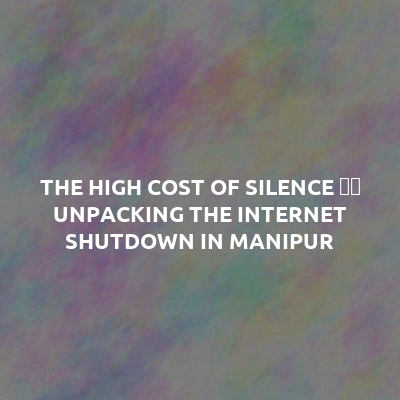The internet, once hailed as a tool of empowerment and connection, has in Manipur turned into a switch that the state frequently flips off in the name of law and order. Since May 3, 2023, Manipur has witnessed an unprecedented internet blackout lasting for over 210 days, the longest such shutdown in the state’s history and one of the longest in democratic India after Jammu & Kashmir. Even before this, Manipur had seen periodic shutdowns over the years, but never at such scale and intensity. While the government cites the need to prevent the spread of misinformation and curb violence, the prolonged and repeated clampdown has had devastating consequences for citizens, businesses, students, and the state’s own economy.
At the heart of this disruption is a fundamental contradiction: in trying to contain conflict, the government has choked an essential lifeline of modern life. From mobile banking and UPI transactions to online education and digital governance, internet access has become a public utility as critical as electricity or water. In its absence, citizens were forced to queue outside cyber cafés where satellite or fiber connectivity remained — paying exorbitant rates just to access exam forms, job applications, or withdraw money. Others, particularly in rural or conflict-hit areas, were simply left out altogether.
The economic impact of these shutdowns on consumers and small traders has been severe. According to estimates by the Internet Society and SFLC.in, India loses around $1.9 million per hour during internet shutdowns. With over 257 total shutdown days in Manipur between 2017 and mid-2025, the loss runs into hundreds of millions of dollars. E-commerce services collapsed, local startups faced losses or shutdowns, and even brick-and-mortar businesses that relied on online orders or payments were paralyzed. Traders at Khwairamband and other commercial hubs were unable to communicate with clients or suppliers, leading to supply chain breakdowns and unsold inventories.
Banking services were no less affected. Automated systems in cooperative banks, microfinance institutions, and even nationalized banks stalled. Customers could not receive or transfer money, check balances, or use mobile banking apps. Many pensioners and daily wage earners were unable to withdraw cash as digital queues replaced physical ones, and ATMs ran dry due to backend disruptions. Even basic government-to-citizen services like Direct Benefit Transfers were delayed or blocked, causing distress to thousands of beneficiaries.
Students, meanwhile, bore one of the heaviest burdens. In a post-COVID world where education has increasingly migrated online, they were locked out of classes, study materials, assignments, and digital examinations. For many in Manipur, who rely on smartphones and cheap data plans instead of personal laptops and broadband connections, the shutdown was tantamount to educational exile. National-level entrance exams like NEET and CUET, which require online registration and preparation, became inaccessible for many. The digital divide in India is real, and in Manipur, it was brutally widened.
Employees in both the private and public sectors faced communication blackouts, missed project deadlines, and were unable to coordinate with national offices. Freelancers and IT professionals — many of whom work remotely for mainland or international clients — lost contracts and credibility, compounding the already high unemployment stress in the state. Even government offices dependent on cloud-based services or email communication suffered, impacting decision-making and welfare service delivery.
At the state level, the costs were enormous. Aside from the direct economic losses, Manipur’s image as a digitally connected, investment-ready region took a severe beating. Potential investors and industries now view the state as a high-risk zone for business continuity. The tourism sector, which had shown signs of revival before the crisis, crumbled without digital promotion and booking infrastructure. The shutdowns also hampered disaster response during the recent floods, as information sharing was delayed and relief coordination became chaotic.
The decision to extend internet bans without transparent justification, periodic review, or proportionality defies the spirit of constitutional freedoms. The Supreme Court in Anuradha Bhasin vs Union of India (2020) clearly stated that indefinite internet shutdowns are unconstitutional. Yet in Manipur, shutdown orders were issued in a copy-paste manner, rarely making public the evidence justifying their necessity. This time however, the internet ban was cut short relieving the users.
Internet bans should be a tool of last resort, targeted, time-bound, and justified — not a blanket weapon wielded against uncertainty. Manipur’s prolonged shutdown has only deepened isolation, fostered mistrust, and delayed reconciliation. What is urgently needed is a policy that balances security concerns with citizens’ rights and economic welfare. The internet, after all, is not the cause of unrest — it is merely the mirror reflecting it.
The High Cost of Silence — Unpacking the Internet Shutdown in Manipur
240



